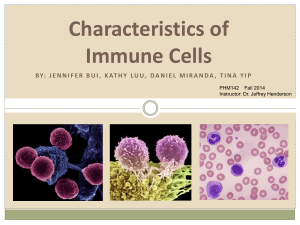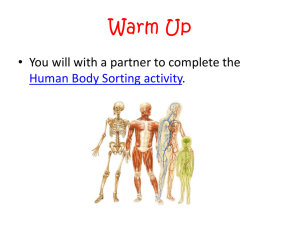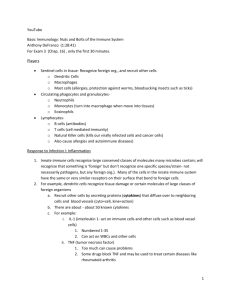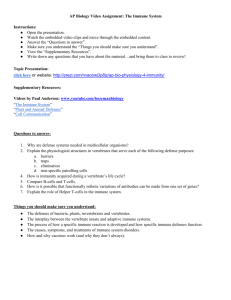(non-specific) immune system
advertisement
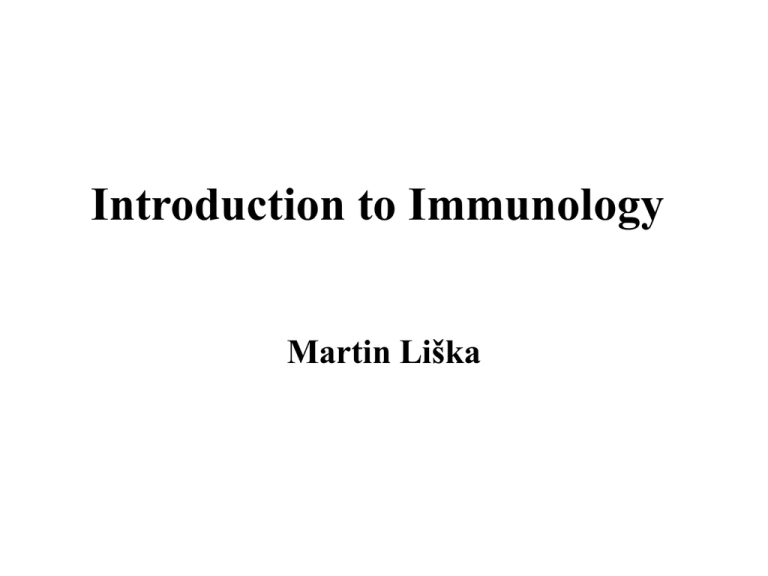
Introduction to Immunology Martin Liška The immune system and its importance for homeostasis of organism • The immune system = a system of non-specific and specific mechanisms protecting the organism from damage caused by infectious factors of environment and providing surveillance of own structures (elimination of damaged and death cells) • The aim is maintenance of homeostasis and integrity of macroorganism Mechanisms of immune system and their cooperation 1/ Innate (non-specific) immune system - innate, not developed after the exposition to infection - uniform response, prompt, no immunological memory - mechanical barriers (mucosa, skin) phagocytic cells (microphages, macrophages) acute phase proteins (CRP) complement system Mechanisms of immune system and their cooperation 2/ Adaptive (specific) immune system - adaptability, developed after the exposition to infection - the immune response is not inherited, immunological response - B and T cells, immunoglobulins 1/ Cells The components of immune system a/ innate immune system - neutrophils, eosinophils, basophils - macrophages - nature killer cells (NK cells) b/ adaptive immune system - lymphocytes The components of immune system 2/ Organs - liver, skin etc. - primary lymphoid organs – bone marrow, thymus - secondary lymphoid organs - spleen, lymph nodes, mucus associated lymphoid tissue (MALT) The components of immune system 3/ Substances - The complement system - Cytokines – molecules which ensure the communication between the components of immune system (e.g.IFN, IL, growth factors) - Acute phase proteins (CRP, MBL) - Hormones (immunostimulatory/immunesuppressive effects) - Immunoglobulins The immune system of mucosa and skin 1/ Mucosa - intact surface, clearance of surface (microcillia, saliva, tears, urine) - lysozyme - IgA - lymphoid tissue of mucosa (MALT) - macrophages (dendritic cells) The immune system of mucosa and skin 2/ Skin - intact surface - lipid barrier (eczema) - immunocytes of the skin (e.g. Langerhans cells) Non-specific immune mechanisms 1/ Barriers - see above (skin, mucosa) - secretions (fatty acids, HCl, lysozyme) 2/ Various physiological mechanisms - body temperature - hormones Non-specific immune mechanisms 3/ Phagocytosis - the process by which particular substances or cells are ingested and destroyed by specialized cells - neutrophils, macrophages (monocytes, tissue macrophages) Neutrophils • The most abundant population of leucocytes (cca 70%) • Granulocytes • They stain a neutral pink when stained by H&E • Nucleus divided into 2-5 lobes, cytoplasm with granules • Neutrophils participate in defense against extracellular pathogens Neutrophils • The average half-life in circulation is about 12 hours • Upon activation, they marginate (position adjacent to the endothelium) → rolling (selectins) → adhesion to endothelium (integrins) → diapedesis (integrins) → chemotaxis (movement toward sites of inflammation by cytoplasmic streaming in response to chemotaxins (IL-8, IFN-g, C5a) → binding to microbe Neutrophils - phagocytosis • Interaction with some surface molecules of microbes (PAMPs, lectin interactions, binding of TLR to some surface molecules of microorganisms) • Opsonisation (= enhancement of binding of phagocytes to microbes) – Ig, complement system components, CRP, MBL Neutrophils - phagocytosis • Surrounding of microorganism → forming of vacuole (phagosome) → fusion with the lysosome → phagolysosome • Phagosome formation depends on contractile proteins action Neutrophils – intracellular destruction of microbes 1/ Oxygen independent systems • substances that are contained in granules • myeloperoxidase, lysozyme, alkaline phosphatase, lactoferrin → hydrolysis microbe’s cell wall components • defensins → forming of channels in microbial cell membrane Neutrophils – intracellular destruction of microbes 2/ Oxygen-dependent systems • Respiratory burst • NADPH oxidase system → production of reactive oxygen agents (hydrogen peroxide, superoxide anion, singlet oxygen, hydroxyl radicals) • Disorder of this system in CGD Neutrophils – intracellular destruction of microbes 2/ Oxygen-dependent systems • Myeloperoxidase, in the presence of toxic oxygen metabolites, catalyzes peroxidation of surface molecules on microorganisms Macrophages • Intracellular destruction of microorganisms mainly by NO synthase (system stimulated by the action of IFN-g or TNF) • Production of numerous substances: lysozyme, some components of the complement system, oxygen metabolites (H2O2, NO), cell function regulators (IL-1, IFN-a), arachidonic acid metabolites, endogenous pyrogens Natural killer cells • Granular lymphocytes, different from T- and Blymphocytes • Cytotoxicity to tumor cells and virally infected autologous cells (perforins) • Play a role in defense against some bacterial, fungal and helminthic diseases • Participate in reactions of antibody-dependent cellmediated cytotoxicity (ADCC) • They are not subject to MHC restriction (= NK-cells do not need to recognize MHC molecules in the target cells) Natural killer cells • They kill target cells by perforins (formation of channels, abnormal ion flux, depolarization, essential metabolite leakage, cell destruction) • NK cells are protected against perforins by specialized cell membrane protein (protectin) Interferons • Proteins that induce antiviral activity in cells • We can distinguish two types: a/ type I: IFN-a (macrophages and other cells) IFN-b (fibroblasts) b/ type II: IFN-g (T-lymphocytes) Function of interferons • Stimulation of cell production of antiviral proteins (protein kinase, oligonucleotide polymerase – interference with the translation of viral mRNA) • Enhancement of T-cell activity • Activation of macrophages • Enhancement of NK cells cytotoxic action Adaptive immune mechanisms 1/ Humoral - generation of antibodies (Ig) – B cells (plasma cells) - in majority of antigens, the cooperation with T helper cells is necessary 2/ Cell-mediated - generation of antigen-specific T cells (helper, cytotoxic) - antigen presentation is necessary Adaptive immune mechanisms • Antibodies → neutralization and opsonization (specific „adapter“) of microbes, complement system activation • T cells → cytotoxic effects to microbes, help for B cells, macrophages activation, cytokines Innate/adaptive immune mechanisms • Innate (non-specific) immune system: prompt reaction x less effective, less directed • Adaptive (specific) immune system: slower development of reaction x more effective, more directed, immunological memory • Both systems cooperate (complement system is activated by IC, cytokines recruit other cells to the site of reaction, antigen presentation)


